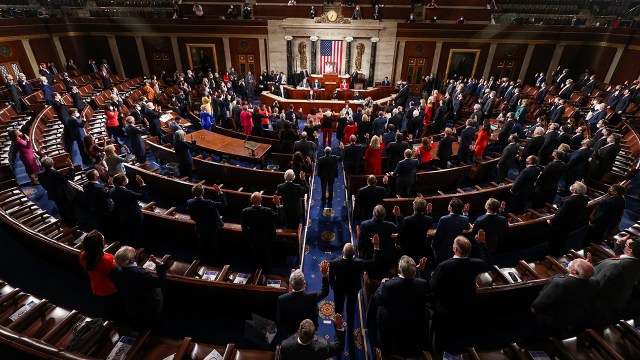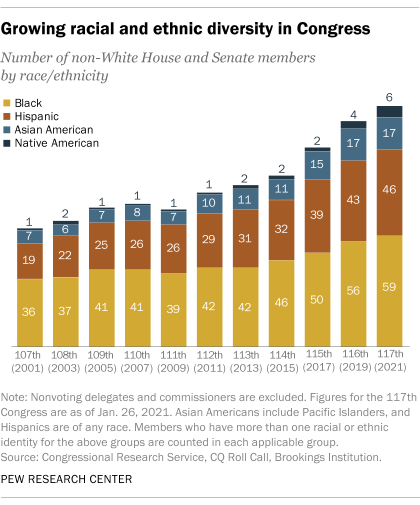What Is The Racial Makeup Of The Senate

About a quarter of voting members (23%) of the U.S. Business firm of Representatives and Senate are racial or indigenous minorities, making the 117th Congress the most racially and ethnically diverse in history. There has been a long-running trend toward higher numbers of non-White lawmakers on Capitol Hill: This is the sixth Congress to break the record set by the one earlier it.

Overall, 124 lawmakers today place every bit Blackness, Hispanic, Asian/Pacific Islander or Native American, co-ordinate to a Pew Research Center analysis of data from the Congressional Inquiry Service. This represents a 97% increment over the 107th Congress of 2001-03, which had 63 minority members.
Among today's senators and representatives, the overwhelming majority of racial and indigenous minority members are Democrats (83%), while 17% are Republicans. This represents a shift from the last Congress, when only 10% of non-White lawmakers were Republicans. Our analysis reflects the 532 voting members of Congress seated as of January. 26, 2021.
This analysis builds on earlier Pew Research Center work to analyze the racial and ethnic makeup of the U.S. Congress. To determine the number of racial and ethnic minority lawmakers in the 117th Congress, we used data from the Congressional Enquiry Service. U.Due south. population data comes from the U.S. Census Bureau. Historical data was pulled from CQ Roll Phone call, CRS and the Brookings Institution. All racial groups refer to single-race not-Hispanics. Hispanics are of any race. Native Hawaiian Rep. Kai Kahele (D-Hawaii) is counted with the Native American lawmakers.
Our analysis reflects the 532 voting members of Congress seated as of Jan. 26, 2021. In the Business firm, one New York race has not been called still, and 1 Louisiana seat is empty because the congressman-elect died before he could be sworn in. We did not include onetime Louisiana Rep. Cedric Richmond, who resigned in January to join the Biden administration. The current number of voting House members is 432. Biden administration nominees who were not yet confirmed at the time of writing are included in our count. Independent members of Congress are counted with the party they conclave with.
Although contempo Congresses have continued to fix new highs for racial and ethnic variety, they have yet been disproportionately White when compared with the overall U.S. population. Non-Hispanic White Americans account for 77% of voting members in the new Congress, considerably larger than their lx% share of the U.S. population overall. This gap hasn't narrowed with time: In 1981, 94% of members of Congress were White, compared with eighty% of the U.S. population.

In the House of Representatives, however, representation of some racial and ethnic groups is now on par with their share of the full population. For example, thirteen% of Firm members are Black, virtually equal to the share of Blackness Americans. And Native Americans now brand up almost 1% of both the Firm and the U.Due south. population.
Other racial and ethnic groups in the House are somewhat less represented relative to their share of the population. The share of Hispanics in the U.Due south. population (19%) is virtually twice as high every bit it is in the House (nine%). Asian Americans and Pacific Islanders together account for six% of the national population and 3% of House members.
This analysis includes 4 representatives who are counted nether more than than ane racial or ethnic identity: Rep. Robert Scott, D-Va., is counted as Blackness and Asian. Reps. Antonio Delgado and Ritchie Torres, both New York Democrats, are listed as Black and Hispanic. Rep. Marilyn Strickland, D-Wash., is both the first Black lawmaker to represent the state and one of the start Korean American women to exist elected to Congress. Native Hawaiian Rep. Kai Kahele (D-Hawaii) is counted with the Native American lawmakers. Portuguese American members are not included in the Hispanic count.
In the Business firm, Republicans business relationship for a larger share of newly elected minority representatives than in the past. Of the 16 freshmen representatives who are non-White, ix are Republicans, compared with just one of the 22 new representatives in the 116th Congress. This freshman accomplice includes the only two Black Republicans in the chamber: Burgess Owens of Utah and Byron Donalds of Florida.
11 senators are a racial or ethnic minority, up from nine in the 116th Congress. Six senators are Hispanic, two are Asian and iii are Black. Freshman Raphael Warnock is the start Black senator to stand for Georgia, and another freshman, Alex Padilla, is the starting time Hispanic senator to stand for California. Padilla replaced Vice President and former Sen. Kamala Harris, who was one of iv women of color (and the simply Black woman) serving in the Senate.
Just three of the 11 non-White senators are Republicans: Tim Scott of Due south Carolina is Black, and Marco Rubio of Florida and Ted Cruz of Texas are both Hispanic.
Source: https://www.pewresearch.org/fact-tank/2021/01/28/racial-ethnic-diversity-increases-yet-again-with-the-117th-congress/
Posted by: perezuncer1996.blogspot.com

0 Response to "What Is The Racial Makeup Of The Senate"
Post a Comment